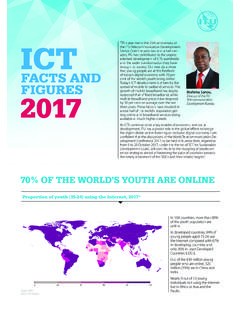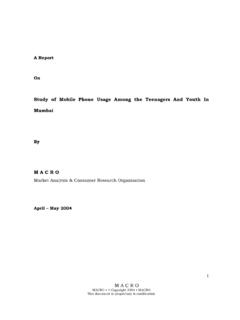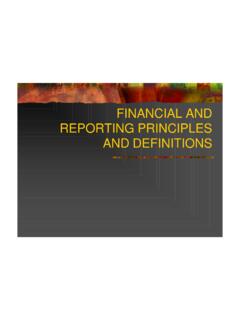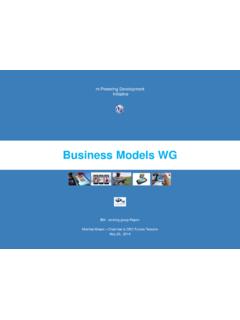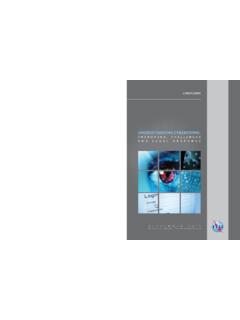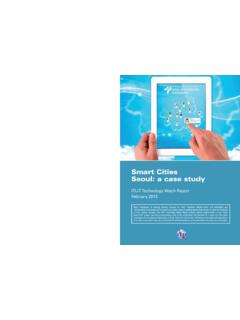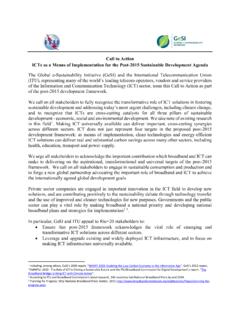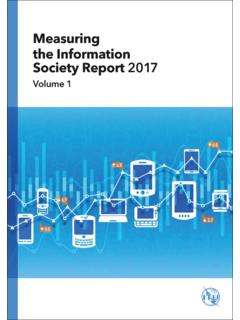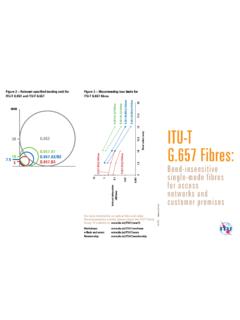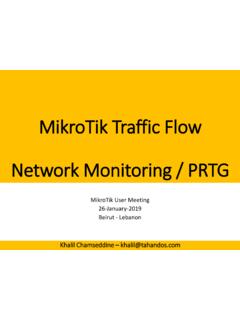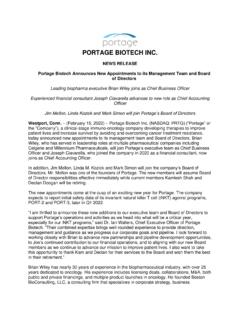Transcription of The ICT Development Index (IDI) - ITU
1 The ICT Development Index (IDI)Methodology, indicators and definitions(as of February 2019)ICT Data and Statistics DivisionTelecommunication Development BureauInternational Telecommunication UnionIDI METHODOLOGYT hree stages in the evolution towards an information societyThe ICT Development Index (IDI) The IDI is a composite Index that combines 14 indicators Designed to be global and reflect changes taking in place in countries of different levels of Development Was developed by ITU in 2008 in response to member states request to establish an overall ICT Index Results first reported in the Measuring the Information Society Report (MISR) 2009 Objectives of the IDITo measure: the level and evolution over time of ICT developments in countries and the experience of those countries relative to other countries; progress in ICT Development in both developed and developing countries; the digital divide, differences between countries in terms of their levels of ICT Development .
2 And the Development potential of ICTs and the extent to which countries can make use of them to enhance growth and meeting of EGTI/EGH Held in Geneva, Switzerland, on 1-3 March 2017 Meeting was open to all ITU members and experts in the field of ICT statistics and data collection Objective -to discuss, debate and agree on a revised set of indicators to be included in the IDI Two input documents prepared by the sub-group and the independent group of experts Adopted a total of 14 indicators to be included in the IDI compared to the previous list of 11 IDI: Indicators dropped in 2018 Access sub-indexUse sub-indexSkills sub-indexFixed-telephone subscriptions (/100 inhabitants)Mobile-cellular telephonesubscriptions(/100 inhabitants)International Internet bandwidth (bit/s/Internet user)Households with a computer (%)Households with Internet access (%)Individuals using the internet (%)Fixed-broadband subscriptions (/100 inhabitants)Active mobile-broadband subscriptions (/100 inhabitants)Mean years of schooling (years)Secondary gross enrollment ratio (%)Tertiary gross enrollment ratio (%)Revised IDI.
3 Indicators added in 2018 Access sub-indexUse sub-indexSkills sub-indexHouseholds with a computer (%)Households with Internet access (%)International Internet bandwidth (bit/s)per Internet userPopulation covered by 3G mobile networksIndividuals using the Internet (%)Active mobile-broadband subscriptions (per 100 inhabitants)Mobile-broadband Internet traffic (per mobile-broadband subscription)Fixed-broadband Internet traffic (per fixed-broadband subscription)Mobilephone ownership (%)Mean years of schoolingSecondary gross enrollment ratio (%)Tertiary gross enrollment ratio (%)Individuals with ICT skills (%)1. Copying or moving a file or folder2. Using copy and paste tools to duplicate or move information within a document3. Sending e-mails with attached files4. Using basic arithmetic formula in a spreadsheet5. connecting and installing new devices6.
4 Creating electronic presentations with presentation software7. Finding, downloading, installing and configuring software8. Transferring files between a computer and other devices9. Writing a computer program using a specialized programming language-At least 3G (%)-At least LTE/WiMAX (%)Fixed-broadband subscriptions by speed tiers-256 kbit/s to 2 Mbit/s (% of total)-2 to 10 Mbit/s (% of total)-Equal to or above 10 Mbit/s (% of total)IDI aggregation methodologyThree data sources Telecommunication data Usually collected by the regulator from operators International data collection through the ITU WTI questionnaire Household/individual ICT data Usually collected by the NSO through a household survey International data collection through the ITU household questionnaire Education data Usually collected by the education ministry International data collection by the UNESCO Institute for Statistics (UIS)
5 ITU doesn t collect data from countries, but uses data from UISThe ICT Development Index Households with a computer (%) Individuals using the Internet (%) Mean years of schooling (years) Households with Internet access (%) Active mobile-broadband subscriptions (/100 inhabitants) Secondary gross enrollment ratio (%) International Internet bandwidth (bit/s/Internet user) Mobile-broadband Internet traffic (/subscription) Tertiary gross enrollment ratio (%) Population covered by mobile networks (%) Fixed-broadband Internet traffic (/subscription) Individuals with ICT skills (%) Fixed-broadband subscriptions by speed tiers (% of total) Individuals who own a mobile phone (%)HHWTI HANDBOOKITU Handbook Covers 81 indicatorson telecommunication/ICT services Covers data collected from administrative sources( telecom operators) Discussed in the ITU Expert Group on Telecom/ICT Indicators (EGTI) Available at: Handbook (cont.)
6 Groupings: Fixed-telephone networks Mobile-cellular networks Internet Traffic Tariffs Quality of service Persons employed Revenue Investment Public access Broadcasting and other indicators Definition Clarifications and scope Method of collection Relationship with other indicators Methodological issues ExamplesITU Handbook additions Revision of revenue and investment indicators New indicators from administrative sources 2011-2013 Fixed broadband and mobile QoS Broadband Internet traffic Pay-TVsubscriptions Mobile-broadband prices New indicators from administrative data sources added in 2015: M2M mobile-network subscriptions Fixed-broadband subscriptions for organizations Percentage of the population covered by at least an LTE/WiMAX mobile network Subscriptions to bundled telecommunication servicesITU Handbook additions (ii) New indicators from 2016: Active subscriptions to LTE/WiMAX mobile-broadband networks Change in mobile-bb sub-categoriesITU Handbook additions (iii) New indicators from 2017: Fixed wired network coverage Extension fixed-broadband speed tiers Modification price baskets Methodological note on the indicator Fixed-broadband Internet traffic ITU Handbook additions (iv) March 2018 Administrativeindicatorscollectedby countriesIndicatorsITU HandbookIndicators collected in ITU administrative questionnairesContext.
7 Indicators from administrative sourcesAdmin indicators included in theICT Development Index96681 Data per operator Sub-national data Data for market analysis Data to track national ICT policiesInternationalNationalHOUSEHOLD MANUALITU Manual (2014) Chapter 1. Introduction Chapter 2. Coordinationamong national stakeholders in ICT measurement Chapter 3. Planning and preparation for ICT household surveys Chapter 4. Statistical standards and measurement topics for ICT household statistics Chapter 5. Data sources and collection techniques for ICT household statistics Chapter 6. Question and questionnairedesign for ICT household surveys Chapter 7. DesigningICT household surveys Chapter 8. Data processing for ICT household statistics Chapter 9. Data quality and evaluation for ICT household statistics Chapter 10. Disseminationof ICT household data and metadataPreparationand revisionprocess First release in 2009 2012-13: tworounds of completerevisions CommentsfromExpert Group on HouseholdIndicators (EGH) forum Version 2 launchedat WTIS 2013 (December2013, Mexico) Revisionof indicatorsin 2014-2015: addedHH16 HH17, HH18, HH19 on the website, but not yetin the ManualITU statistical standards: ICT householdstatistics Statistical standards associated with the core ICT indicatorsfor household accessto, and individual useof, ICT: concepts definitions of terms model questions classificatory variables (breakdowns) scope units (households and individuals) Formula of calculation Use (policyrelevance)Core household indicators, main concepts The indicators consist of those.
8 Referring to household accessto ICT equipment and services Referring to individuals use/ownershipof ICT equipment and servicesConcept of access ICT device/service should be available for use of any member of the household at any time Device can be owned or not by the household Applies to all indicators referring to household ICT access Device should be in a working conditionAge scope Countries should report ICT usage information for the three main core indicators on individuals use of ICTs (computer, mobile phone and Internet) for the entire population of the country, there is no minimum age scopeany more for these indicatorsReference period Information on ICT usage should be collected and reported with a reference period of the last 3 monthsConducting household surveys Much more in the separate presentation Getting ICT data through surveys with information on: Collaborating and coordinating for household ICT statistics Getting ICT data through surveys: good practices The ITU Manual Data disaggregationsIDI INDICATORS -DEFINITIONSIDI indicator Percentage of households with a computer Access sub- Index Source: Household surveyIndicator HH4: Proportion of households with a computer Definitions: This is the proportion of households that have a computer.
9 A computer refers to a desktop computer, a laptop (portable) computer or a tablet (or similar handheld computer). Desktop: a computer that usually remains fixed in one place; normally the user is placed in front of it, behind the keyboard. Laptop (portable) computer: a computer that is small enough to carry and usually enables the same tasks as a desktop computer; it includes notebooks and netbooks but does not include tablets and similar handheld computers. Tablet (or similar handheld computer): a tablet is a computer that is integrated into a flat touch screen, operated by touching the screen rather than (or as well as) using a physical keyboard. It does not include equipment with some embedded computing abilities, such as smart TV sets, and devices with telephony as their primary function, such as smartphones.
10 IDI indicator Percentage of households with Internet access Access sub- Index Source: Household surveyIndicator HH6: Proportion of households with Internet Definitions: This is the proportion of households with Internet access at home. The Internet is a worldwide public computer network. It provides access to a number of communication services including the World Wide Web and carries e-mail, news, entertainment and data files, irrespective of the device used (not assumed to be only via a computer it may also be by mobile telephone, tablet, PDA, games machine, digital TV etc.). Access can be via a fixed or mobile network. IDI indicator International Internet bandwidth (bit/s) per Internet user Access sub- Index Source: WTII nternational Internet bandwidthITU collects data on two capacityi4214u: Used international bandwidth (traffic), in Mbit/sAverage usage of all international links including fiber-optic cables, radio links and traffic processed by satellite ground stations and teleports to orbital satellites (expressed in Mbit/s).
